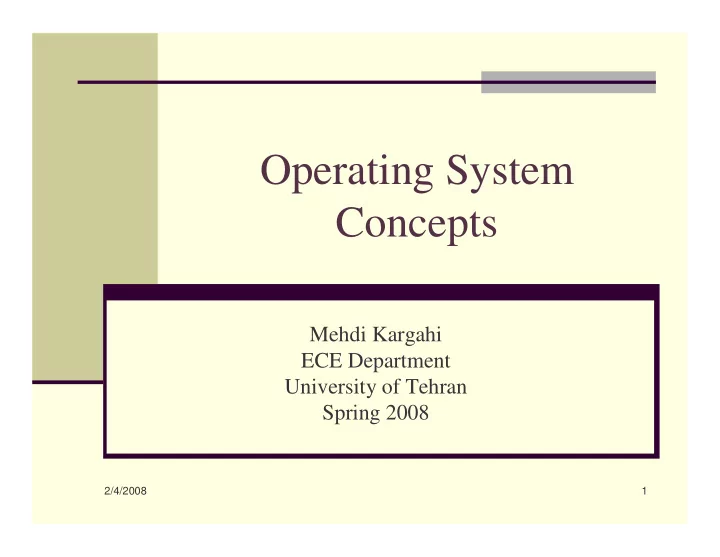

Operating System Concepts Mehdi Kargahi ECE Department University of Tehran Spring 2008 1 2/4/2008
Reference � A. Silberschatz, G. Gagne, and P. B. Galvin, “Operating System Concepts”, 7th Ed., 2005. 2/4/2008 2
Course Plan Theoretical concepts 1. � Exercises � Quiz � Midterm � Final Class participation 2. Projects 3. � Linux & Windows � Small scale kernel programming Exercise class participation 4. 2/4/2008 3
Course Outline � Introduction (Terminologies & Overview) � Different Structures of Operating Systems � Processes and Threads � CPU Scheduling (Approaches and Algorithms) � Process Synchronization: Facts and Mechanisms � Resource Sharing and Deadlock � Main and Virtual Memory Management � Storage Management � Protection & Special Purpose Systems 2/4/2008 4
Components of a Computer System 2/4/2008 5
Definitions � User View � Single-user (ease of use, performance) � User at a terminal of a mainframe (fair sharing) � User at a workstation on a network of servers (a tradeoff between usability & resource util.) � PDAs (performance/amount of battery life) � Embedded systems (almost no user intervention) � System View � Efficient and fair allocation of resources � Controlling programs to prevent errors and improper use of the computer (operations and I/O devices) 2/4/2008 6
Computer-System Organization � Firmware: Bootstrap program (in ROM or EEPROM) � Initializes CPU registers, device controllers, memory contents � Locates and loads into memory the OS kernel 2/4/2008 7
How the OS Discovers the Occurrence of an Event � Polling � Interrupt � From hardware by a signal sent to the CPU � From software by system call (monitor call) � Interrupt time line for a single process doing output 2/4/2008 8
Interrupts � Interrupts inform the completion of I/O to the CPU � Interrupt Service Routine (ISR) � Device drivers? � Typically: A device driver for each device controller! � Examples � Direct Memory Access (DMA) � What OS does with respect to DMA? � Determination of buffers, pointers, and counters for the I/O device � Sending the start command � The Completion of transfer will be notified by an interrupt � DMA steals memory cycles from CPU to access the bus 2/4/2008 9
The Interplay of Components of a Computer System 2/4/2008 10
Computer-System Architecture � Single-Processor Systems � Multiprocessor Systems � Clustered Systems 2/4/2008 11
Single-Processor Systems � Range from PDAs to mainframes � They may have special-purpose processors for I/O devices 2/4/2008 12
Multi-Processor (Tightly-Coupled) Systems � Sharing � the computer bus, sometimes the clock, memory, and peripheral devices � Main advantages � Increased throughput: the speedup with N processors in not N due to overheads, contention for shared resources, and that the degree of requests is not N times of a single-processor system � Economy of scale: due to sharing of resources � Increased reliability: just slows down due to failure � Graceful degradation � Fault tolerance: differs from graceful degradation 2/4/2008 13
Multi-Processor (Tightly-Coupled) Systems � Two types (HW/SW) � Asymmetric multiprocessing � Master-slave relationship (e.g., SunOS Ver. 4) � Symmetric multiprocessing (SMP) � E.g., Windows, Linux, and Mac OS � Multi-core CPUs � Blade servers � Multiple processor boards, I/O boards, and networking boards on the same chassis � They boot independently and run their own OS 2/4/2008 14
Clustered Systems � Two or more individual systems coupled together � Share storage � Linked via a LAN or InfiniBand � High availability � Clustering � Asymmetric (Hot-standby) � Symmetric � Parallel clusters: allow multiple hosts to access the same date on the shared storage � Clustering over a WAN 2/4/2008 15
Operating-System Structure � Program vs. process/task/job � Batch systems � Buffering � Spooling � Multiprogramming � Increasing CPU utilization � Jobs are loaded into memory � Scheduling & Memory management � Switching at job completion/wait for IO � Time-sharing (Multitasking) � User interaction with the system � Switching between users and tasks with high freq. � Switching at job completion/wait for IO/completion of time-slice 2/4/2008 16
Operating-System Structure � Job scheduling � Selecting a job from the job pool to be loaded into memory � CPU scheduling � Selecting the next ready job to run � Virtual memory � Tries to separate logical memory from physical memory through swapping � Time sharing may require CPU sch., mem. and virtual mem. managements, file system, disk management, protection of resources, job synchronization, deadlock management 2/4/2008 17
Operating-System Operations � Modern operating systems are interrupt-driven � Trap is a software interrupt � Dual-Mode operation (through mode bit) � User mode (1) � Kernel (Supervisor, System, or Privileged) mode (0) � Privileged instructions 2/4/2008 18
Privileged Instructions � The instruction to change mode bit � I/O instructions � Timer management � Interrupt (and interrupt vector) management � What would be occurred if it was not privileged? � … � Errors violating modes are detected by the hardware and it will trap to the OS. The trap transfers control through the interrupt vector to the OS. 2/4/2008 19
Timer � Fixed or variable timer � Preventing a program from getting stuck in an infinite loop � Time sharing 2/4/2008 20
Operating-System Operations � Process Management � Memory Management � Storage Management � File-System � Mass-Storage � Caching � I/O Systems � Protection and Security � Command Interpreter 2/4/2008 21
Recommend
More recommend